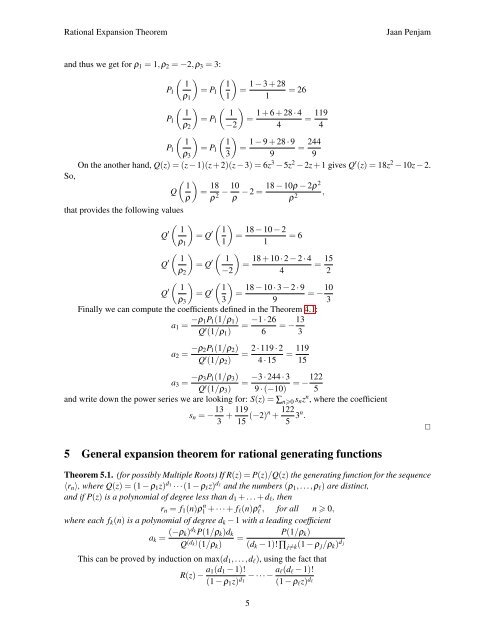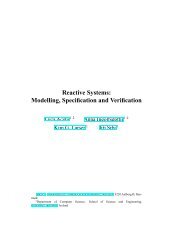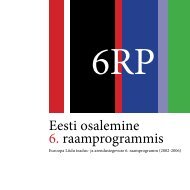Rational functions - Cs.ioc.ee
Rational functions - Cs.ioc.ee
Rational functions - Cs.ioc.ee
You also want an ePaper? Increase the reach of your titles
YUMPU automatically turns print PDFs into web optimized ePapers that Google loves.
<strong>Rational</strong> Expansion Theorem Jaan Penjam<br />
and thus we get for ρ1 = 1,ρ2 = −2,ρ3 = 3:<br />
So,<br />
<br />
1 1<br />
P1 = P1 =<br />
ρ1 1<br />
1 − 3 + 28<br />
= 26<br />
1<br />
<br />
1 1<br />
P1 = P1 =<br />
ρ2 −2<br />
1 + 6 + 28 · 4<br />
=<br />
4<br />
119<br />
4<br />
<br />
1 1<br />
P1 = P1 =<br />
ρ3 3<br />
1 − 9 + 28 · 9<br />
=<br />
9<br />
244<br />
9<br />
On the another hand, Q(z) = (z − 1)(z + 2)(z − 3) = 6z3 − 5z2 − 2z + 1 gives Q ′ (z) = 18z2 − 10z − 2.<br />
Q<br />
that provides the following values<br />
<br />
1<br />
ρ<br />
= 18 10<br />
−<br />
ρ2 ρ<br />
18 − 10ρ − 2ρ2<br />
− 2 =<br />
ρ2 ,<br />
Q ′<br />
<br />
1<br />
= Q<br />
ρ1<br />
′<br />
<br />
1<br />
=<br />
1<br />
18 − 10 − 2<br />
= 6<br />
1<br />
Q ′<br />
<br />
1<br />
= Q<br />
ρ2<br />
′<br />
<br />
1<br />
=<br />
−2<br />
18 + 10 · 2 − 2 · 4<br />
=<br />
4<br />
15<br />
2<br />
Q ′<br />
<br />
1<br />
= Q<br />
ρ3<br />
′<br />
<br />
1<br />
=<br />
3<br />
18 − 10 · 3 − 2 · 9<br />
= −<br />
9<br />
10<br />
3<br />
Finally we can compute the coefficients defined in the Theorem 4.1:<br />
a1 = −ρ1P1(1/ρ1)<br />
Q ′ −1 · 26<br />
= = −13<br />
(1/ρ1) 6 3<br />
a2 = −ρ2P1(1/ρ2)<br />
Q ′ (1/ρ2)<br />
= 2 · 119 · 2<br />
4 · 15<br />
= 119<br />
15<br />
a3 = −ρ3P1(1/ρ3)<br />
Q ′ −3 · 244 · 3<br />
= = −122<br />
(1/ρ3) 9 · (−10) 5<br />
and write down the power series we are looking for: S(z) = ∑n0 snzn , where the coefficient<br />
sn = − 13 119<br />
+<br />
3 15 (−2)n + 122<br />
5 3n .<br />
5 General expansion theorem for rational generating <strong>functions</strong><br />
Theorem 5.1. (for possibly Multiple Roots) If R(z) = P(z)/Q(z) the generating function for the sequence<br />
〈rn〉, where Q(z) = (1 − ρ1z) d1 ···(1 − ρℓz) dℓ and the numbers (ρ1,...,ρℓ) are distinct,<br />
and if P(z) is a polynomial of degr<strong>ee</strong> less than d1 + ... + dℓ, then<br />
rn = f1(n)ρ n 1 + ··· + fℓ(n)ρ n ℓ , for all n 0,<br />
where each fk(n) is a polynomial of degr<strong>ee</strong> dk − 1 with a leading coefficient<br />
(−ρk) dkP(1/ρk)dk<br />
ak =<br />
Q (dk)<br />
P(1/ρk)<br />
=<br />
(1/ρk) (dk − 1)!∏j=k(1 − ρ j/ρk) d j<br />
This can be proved by induction on max(d1,...,dℓ), using the fact that<br />
R(z) − a1(d1 − 1)!<br />
(1 − ρ1z) d1 − ··· − aℓ(dℓ − 1)!<br />
(1 − ρℓz) dℓ<br />
5<br />
✷
















